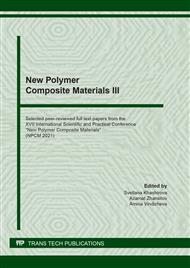[1]
G. Moad, E. Rizzardo, S. H. Thang. Living Radical Polymerization by the RAFT Process—A First Update. Aust. J. Chem. 59 (2006) 669–692.
DOI: 10.1071/ch06250
Google Scholar
[2]
T. Barman, H. Chen, J. Liu, G. Yang, W. Zhao, C. Peng, X. Hou, Synthesis and characterization of styrene-based polyfluoroacrylate film for hydrophobic/icephobic applications, Thin Solid Films. 687 (2019) 137462.
DOI: 10.1016/j.tsf.2019.137462
Google Scholar
[3]
X. Yang, L. Zhu, Y. Zhang, Y. Chen, B. Bao, J. Xu, W. Zhou, Surface properties and self-cleaning ability of the fluorinated acrylate coatings modified with dodecafluoroheptyl methacrylate through two adding ways, Applied Surface Science. 295 (2014) 44–49.
DOI: 10.1016/j.apsusc.2013.12.177
Google Scholar
[4]
B. Améduri, Controlled radical (co)polymerization of fluoromonomers, Macromolecules. 43 (2010) 10163–10184.
DOI: 10.1021/ma1019297
Google Scholar
[5]
K. Koike, Y. Koike, Design of low-loss graded-index plastic optical fiber based on partially fluorinated methacrylate polymer, Journal of Lightwave Technology. 27 (2009) 41–46.
DOI: 10.1109/jlt.2008.928543
Google Scholar
[6]
D.J. Balazs, C. Hollenstein, H.J. Mathieu, Fluoropolymer coating of medical grade poly(vinyl chloride) by plasma-enhanced chemical vapor deposition techniques, Plasma Processes and Polymers. 2 (2005) 104–111.
DOI: 10.1002/ppap.200400039
Google Scholar
[7]
J.A. Gladysz, D. P. Curran, I. T. Horvath (Eds.), Handbook of Fluorous Chemistry, WILEY-VCH, Weinheim, (2004).
Google Scholar
[8]
A. Chandrasegar, K. Juhanni, Synthesis of Poly(Glycidyl Methacrylate) through Reversible Addition Fragmentation Chain Transfer (RAFT) Polymerization. Proceedings Chemistry. 3 (2018) 207.
Google Scholar
[9]
J. Benvenuta-Tapia, J. Tenorio-Lуpez, E. Vivaldo-Lima, Estimation of Reactivity Ratios in the RAFT Copolymerization of Styrene and Glycidyl Methacrylate. Macromolecules 38 (2005) 2691-2695.
DOI: 10.1002/mren.201800003
Google Scholar
[10]
J. Zhang, L. Pan, C. Xiangqiang, Z. Zhu, RAFT Copolymerization of Glycidyl Methacrylate and N,N‐Dimethylaminoethyl Methacrylate. Chines Jourmal of Chemistry. 30 (2012) 2138-2144.
DOI: 10.1002/cjoc.201200625
Google Scholar
[11]
E.M. Muzammil, A. Khan, M.C. Stuparu. Post-polymerization modification reactions of poly(glycidyl methacrylate)s. RSC Adv. 7 (2017) 55874.
DOI: 10.1039/c7ra11093f
Google Scholar


